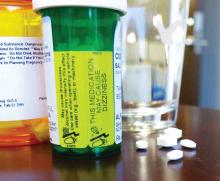ESTES PARK, COLO. – The first-line medications for anxiety disorders are the same ones used for depression – the SSRIs and serotonin and norepinephrine reuptake inhibitors (SNRIs) – but the dosing strategies are quite different, Elizabeth L. Lowdermilk, MD, said at a conference on internal medicine sponsored by the University of Colorado.
“We know that folks with anxiety disorders tend to need the higher doses. They just need to get there a little more slowly,” according to Dr. Lowdermilk, a psychiatrist at the university and medical director of outpatient psychiatry at Denver Health.
“The trick is not what drug you use, it’s what dose you started at. For example, when I start sertraline for depression I start it at 50 mg per day. When I start it for anxiety I start it at 25. I just give it a week or 2 at 25 and then I double it to 50. And then I keep going, titrating over 2-3 months to a high or maximum dose,” she explained.
The rapidity of response to the SSRIs and SNRIs is quite different, too. When patients are started on one of these agents as treatment for depression, they can expect that it will take at least 4-6 weeks and maybe as long as 12 weeks before they experience the full therapeutic effect. Not so when the same drugs are used to treat anxiety disorders.
“The anxiolytic effect seems to be more robust sooner. Really, people start noticing something within the first couple days to a week. And they will keep getting better, which people love,” Dr. Lowdermilk said.
One of the early positive effects of SSRI/SNRI therapy that patients can be advised to be on the lookout for is “the Teflon mind,” she said.
“It’s not that the worried thoughts won’t arise, but they’re going to slide out faster and patients are going to be able to shift their focus back to where they want it to be and move forward,” the psychiatrist explained.
Other positive treatment effects include reductions in irritability, anger, perseverative thoughts, restlessness, and physical tension, along with improved sleep.
How to monitor patient response
The most practical anxiety rating scale for busy primary care physicians with tight office visit scheduling is the seven-item Generalized Anxiety Disorder Assessment, or GAD 7. It can be used repeatedly to follow a patient’s treatment response.
“While technically it is picking up the symptoms of GAD, because there are so many overlapping symptoms in all of the anxiety disorders this is going to give you a sense of whether someone is getting better. It won’t pick up their nightmares if they have PTSD, and it won’t necessarily pick up their checking behaviors if they have obsessive-compulsive disorder – you can ask them quickly about that,” she said.
Augmenting an SSRI/SNRI
Be advised: While some patients with an anxiety disorder will experience complete resolution of symptoms on the maximum approved dose of an SSRI/SNRI, such as 200 mg/day of sertraline (Zoloft), lots of patients will have only a partial response. The next move is not to add a second antidepressant, it’s to augment the high-dose antidepressant the patient is already on with something else. Dr. Lowdermilk highlighted the best and worst strategies:



